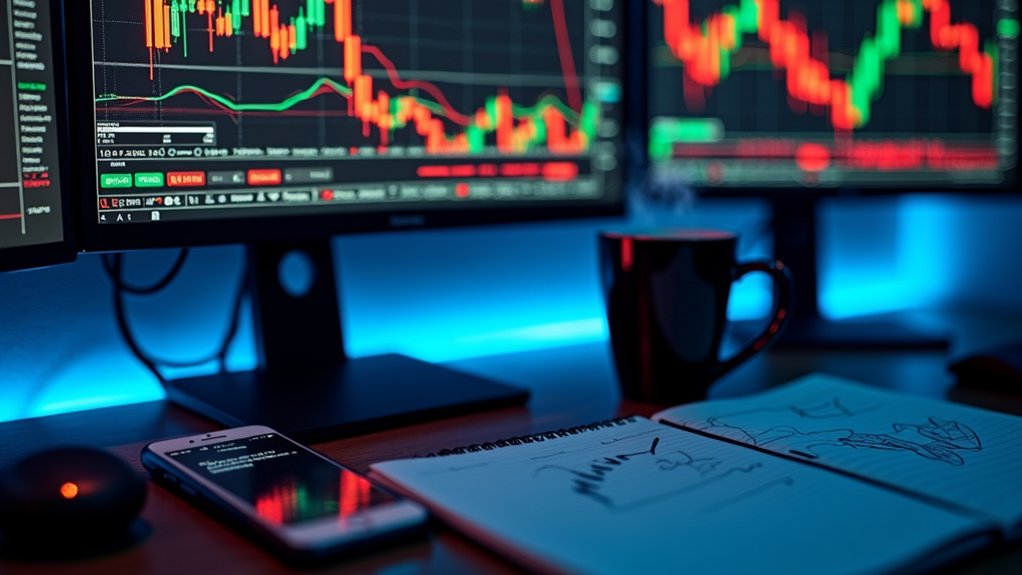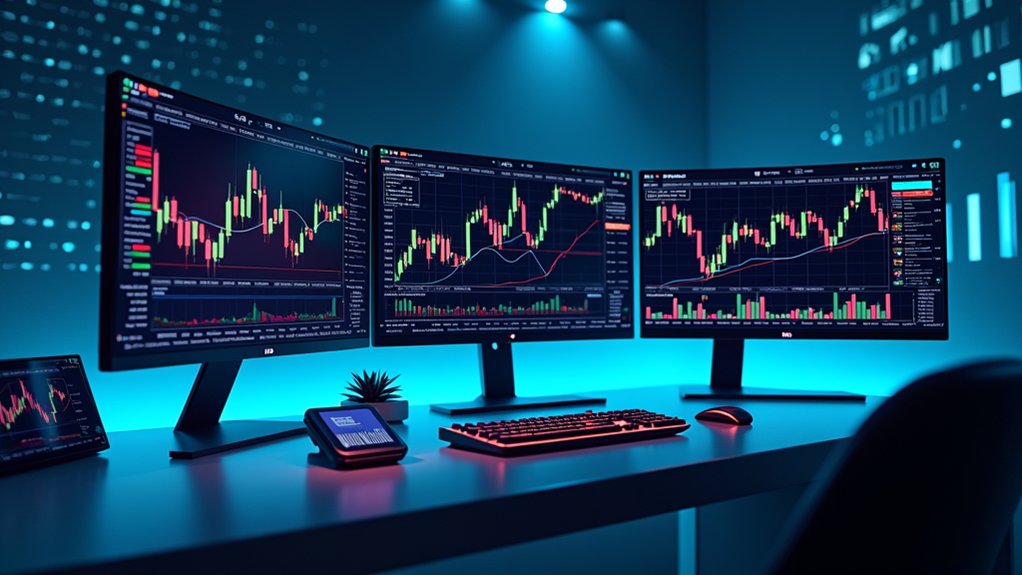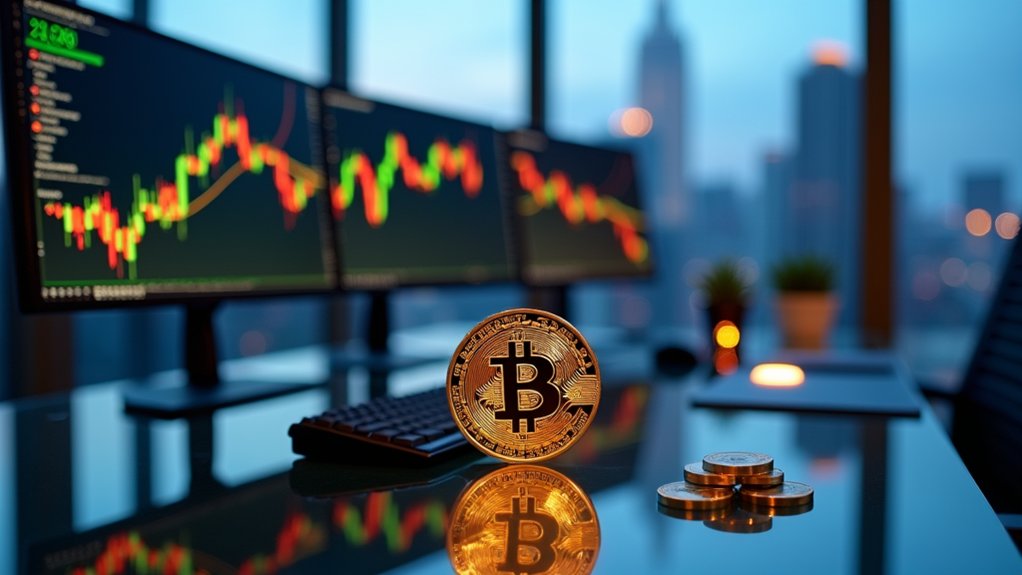Crypto day trading involves executing multiple transactions within 24-hour periods to capitalize on cryptocurrency's intrinsic volatility across global markets. Traders employ momentum-based approaches, scalping techniques, and range trading strategies, using limit orders on exchanges like Binance or Coinbase to automate execution. This high-risk methodology contrasts with long-term "HODL" strategies, requiring strict risk management protocols, precise position sizing, and emotional discipline to navigate market fluctuations effectively. Further exploration reveals sophisticated technical analysis methods that can enhance profitability.

The frenetic world of cryptocurrency markets, operating ceaselessly across global time zones, has given rise to a distinctive trading approach known like crypto day trading. This method diverges markedly from traditional investment strategies by focusing on executing multiple transactions within a single 24-hour period, capitalizing on the fundamental volatility that characterizes digital asset markets. Unlike conventional financial exchanges that operate within limited hours, cryptocurrency markets function continuously, providing traders with unprecedented access to trading opportunities regardless of local time constraints.
Crypto day trading represents a marked departure from the widely popularized "HODL" strategy, wherein investors maintain positions through market cycles with expectations of substantial long-term appreciation. Day traders, conversely, aim to accumulate incremental profits through numerous small-scale transactions, entering and exiting positions rapidly to capture brief price fluctuations. The cryptocurrency market's notorious volatility, which often exceeds that of traditional securities markets by considerable margins, creates an environment where substantial price movements can occur within minutes rather than days or weeks. Successful traders employ technical analysis tools to identify these price movements and make informed decisions about entry and exit points.
While HODLers wait for future riches, day traders dance with volatility, capturing profits in crypto's lightning-fast price movements.
Market participants employing momentum-based approaches monitor news events, social media sentiment, and trading volume indicators to identify assets experiencing strong directional movements. When executed effectively, traders enter positions early in trend development and exit before inevitable corrections occur. Many practitioners also utilize scalping techniques to extract minimal profits from high-frequency trades that may only last seconds or minutes.
Complementary to this, range trading strategies become particularly valuable during consolidation periods, when prices oscillate between established support and resistance levels, allowing traders to purchase at predictable price floors and liquidate holdings at recognized ceilings. Traders often place limit orders on exchanges like Binance or Coinbase to automatically execute trades when assets reach specific price points without requiring constant manual intervention.
The risk profile associated with crypto day trading remains considerably elevated compared to more conservative investment methodologies. Market participants must contend with potential slippage, exchange outages during high-volume periods, and the psychological strain of monitoring positions continuously.
Successful practitioners typically implement strict risk management protocols, including predetermined stop-loss thresholds and position sizing guidelines proportional to their overall capital allocation. Additionally, many deploy algorithmic tools to maintain execution discipline and mitigate emotional decision-making that frequently undermines trading performance during periods of heightened market stress or euphoria.
Frequently Asked Questions
What Taxes Apply to Crypto Day Trading Profits?
Crypto day trading profits are subject to short-term capital gains taxes, which are taxed at ordinary income rates ranging from 10% to 37%, depending on the trader's income bracket.
Additionally, traders may face state income taxes, which vary by jurisdiction.
Those qualifying for Trader Tax Status (TTS) might incur self-employment taxes but gain access to business-related deductions.
Each transaction constitutes a taxable event requiring documentation, regardless of whether a 1099 form is issued.
How Much Capital Should Beginners Start With?
Beginners should generally allocate between $500-1,000 for initial capital, adhering to the 1-2% risk-per-trade principle while pursuing realistic daily profit targets.
Those subject to Pattern Day Trader rules, however, must maintain $25,000 in their accounts if using U.S.-regulated brokers.
Alternative approaches include utilizing offshore platforms, cash accounts, or fractional trading capabilities, which permit participation with less capital while still implementing proper risk management protocols.
Which Exchanges Offer the Lowest Fees for Day Traders?
For day traders seeking minimal fee structures, several exchanges stand out in the current market.
MEXC offers the most competitive rates with 0% maker fees and 0.02% taker fees, while Bybit provides futures trading with negative maker fees (-0.01%) that effectively pay traders for providing liquidity.
Volume-based discounts on platforms like Binance and OKX further reduce costs for active traders, with fee reductions scaling proportionally to monthly trading volume.
Can Automated Bots Improve Day Trading Performance?
Automated trading bots can greatly enhance day trading performance through superior execution speed, processing over 1 million data points per second with latencies like 0.01 seconds.
Research indicates these systems demonstrate 23% higher profitability than manual trading, while simultaneously reducing emotional trading errors by approximately 47%.
Their capacity for continuous operation, consistent rule application, and sophisticated pattern recognition enables traders to implement complex strategies that would otherwise be cognitively demanding or technically unfeasible for human operators.
How Do Market Makers Differ From Regular Day Traders?
Market makers fundamentally differ from day traders in their essential functions and revenue models.
While market makers provide liquidity by continuously posting bid-ask orders and earn from narrow spreads and exchange rebates, day traders consume liquidity by executing trades at prevailing prices, profiting from price movements.
Market makers employ automated algorithms focused on spread capture with minimal directional exposure, whereas day traders utilize technical indicators to capitalize on directional price swings within daily timeframes.









